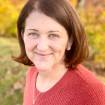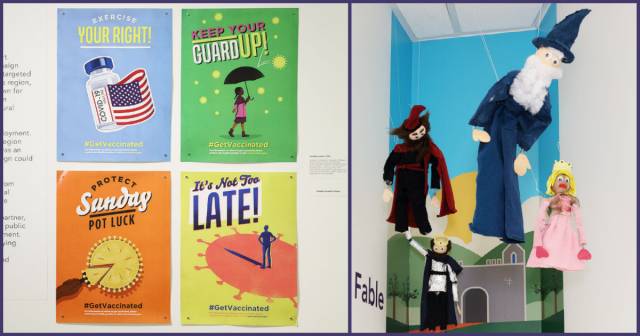You are here
David J. Sencer CDC Museum Celebrates Creative Arts Outreach
A painting depicts a man cautiously stepping through a door that bears the message: Brighter Days are Coming. Behind him, the words loneliness, depression and isolation disappear into the floor.
This image of hope and transformation was created by artist Gregory Ashley through the Trust Transfer Project (TTP), a partnership between the Community Music School of Springfield and the Springfield Cultural Partnership in Massachusetts that engaged more than 150 local artists in Springfield to promote COVID-19 vaccine confidence and community healing.
The TTP artwork is part of a new exhibition at the David J. Sencer CDC Museum in Atlanta, titled Trusted Messengers: Building Confidence in COVID-19 Vaccines Through Art, which showcases original art from six organizations working to increase vaccine acceptance in their communities. Their efforts were part of a 2022 collaboration between the CDC Foundation and the National Endowment for the Arts that supported 30 organizations across the country to use art to build vaccine confidence in creative and memorable ways. Over 600 artists lent their talents to this outreach, and their creations spanned a wide variety of media including posters, public murals, music videos and live performances.
Louise E. Shaw, curator of the David J. Sencer CDC Museum, collaborated with CDC Foundation staff to create an exhibition that shows just how effective the arts can be at finding new, innovative ways to reach communities. Among the installations are four puppets suspended from the ceiling of the lobby gallery, hand-crafted by a group of Michigan high school students with the help of designers from the West Michigan Center for Arts + Technology. The puppets are the stars of Kingdom of Remedy, a short film written and produced by the teenagers to encourage their peers to get vaccinated.
“Protect Sunday Potluck” declares one of the vaccine confidence posters designed by University of Alabama faculty member and acclaimed designer Jonathan Cumberland. Cumberland received the Graphic Design USA Award of Excellence for his vaccine poster designs. The posters were used by the University of Alabama’s Department of Art and Art History in a billboard and poster campaign promoting the benefits of vaccination in counties of west Alabama where vaccine hesitancy was high.
Colorful paper quilt squares arranged on wires mimic the design of a fabric quilt in the Barn Quilt Project installation from the Vermillion Cultural Association and Creative Care in South Dakota. Artists drew on long, cross-cultural quilting traditions in the region by traveling throughout nine communities across the state, including rural areas and tribal reservations, to help South Dakotans craft these geometric designs. At local quilting events, participants were invited to share their own pandemic experiences, and their personal stories of loss and resilience can be found inside each quilt square.
The exhibition also features posters and a music video from Saint Louis Story Stitchers, an artists collective where artists work alongside teens and young adults living in under-resourced neighborhoods. Through their Perception Isn’t Always Reality initiative, Story Stitchers used hip-hop music and krump dance, videography, photography and podcasting to encourage young people to reevaluate misinformation they may have received about COVID-19 and vaccinations.
A large-scale banner showing two people embracing and sharing their reasons for getting vaccinated was designed by Studio Two Three (S23), a community arts space in Richmond, VA. With their Stronger Together project, S23 partnered with Richmond Public Schools to host community events and use public art, including zines, banners and screen-printed items, to increase vaccine confidence.
There is much more to see and experience in Trusted Messengers: Building Confidence in COVID-19 Vaccines Through Art, including videos and documentation of additional projects from across the U.S. Currently scheduled to run through spring 2023, the exhibition and the work of all the organizations serve as examples of how art, in all its forms, can bring people together to create conversations and greater understanding.
To learn more about this exhibit, read this press release from the CDC Foundation.
Photography by Mike Jensen and Courtesy of the David J. Sencer CDC Museum
Funding for this effort is made possible through a subaward from the CDC Foundation and is part of a Centers for Disease Control and Prevention (CDC) of the U.S. Department of Health and Human Services (HHS) financial assistance award totaling $2,500,000.00 with 100 percent funding from CDC/HHS. The contents are those of the author(s) and do not necessarily represent the official views of, nor an endorsement by, CDC/HHS or the U.S. Government.


